All change! These aerial images show how New Street station has been transformed from the 1960s development to today’s stunning building.
The Queen officially reopened the New Street building and Grand Central complex on Thursday November 19.
Accompanied by His Royal Highness The Duke of Edinburgh, Her Majesty unveiled a plaque marking her visit – the first to New Street in her 62-year reign and her first visit to the city since her Diamond Jubilee tour in 2012.
The new station, including the new Grand Central shopping complex and John Lewis store, was unveiled in September after a five-year, £750 million Network Rail project.
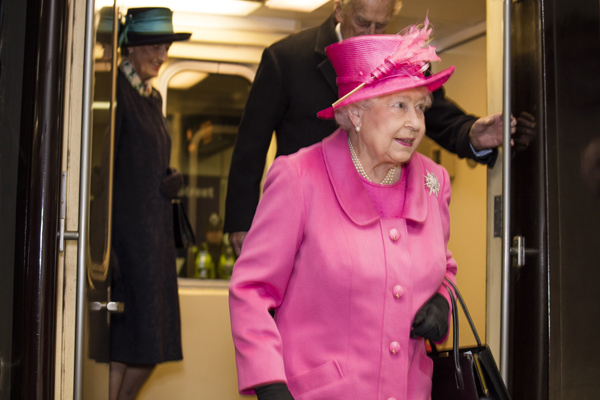
The Queen at New Street station
The Queen and The Duke of Edinburgh were greeted by a host of dignitaries – including Sir Peter Hendy, chairman of Network Rail and Mark Carne, chief executive of Network Rail – after arriving at the station on the Royal Train.
They were shown an exhibition of the station through the ages since it was first built in the 1880s and were introduced to many of those involved in building the latest incarnation.
The Queen and Duke’s visit was broadcast on the station’s largest ‘media eye’ at the front of the station for the public to watch while many also gathered inside.
Boasting an iconic new atrium over a huge passenger concourse – five times the size of London Euston’s – the station has been rebuilt while trains continued to run as normal for the 170,000 passengers a day who use it.
The new station will eventually feature 43 shops at concourse level. Above it sits the new Grand Central shopping complex, including one of the UK’s largest John Lewis department stores.
Pictures: Network Rail press office
New influence and networking group Downtown Birmingham in Business is hosting two free events aimed at small businesses in the city.
Downtown has joined forces with the Library of Birmingham Google Garage for the first event, which takes place on Tuesday, November 17.
Google’s digital experts will be hosting two masterclasses advising businesses how to make the most of their online presence through better use of social media and search engine optimisation.
On Wednesday, November 25, Birmingham-based PR expert Lis Lewis-Jones, of Liquid PR, will talk at a ‘Rise & Grind’ breakfast event about crisis communications and what employers large and small should do when things go wrong, using the recent Volkswagen emissions scandal as an example.
The talk is being held at the new Everyman Cinema at the Mailbox.
Downtown Birmingham in Business is chaired by Edwin Ellis Creative Media director Stacey Barnfield.
For more information and to book visit www.downtowninbusiness.com/birmingham/
We’re delighted to have been appointed by Birmingham’s Retail Business Improvement District (BID) to publish its new bi-monthly magazine.
The 16-page publication, called Edit, will feature BID news and updates and raise the profile of its member businesses at a time of huge growth in the city’s retail sector.
A BID is a defined area within which companies pay an additional tax to fund improvement projects.
Some of the biggest names in the city’s shopping scene, such as John Lewis, Selfridges and Harvey Nichols, contribute to the Retail BID.
In addition, the BID also works with hundreds of independent retailers and outlets across the city centre and in vibrant malls such as Great Western Arcade and Picadilly Arcade.
Edwin Ellis Creative Media will oversee all content, design and photography contained in Edit, with guidance from Retail BID managers Steve Hewlett and Assia Sohaib.
The first edition of Edit, which is due out late November, will feature the BID’s Christmas campaigns, the recent relaunch of the Mailbox and a new city centre pocket map for tourists.
The publication will also look at work being done to make the city centre a safer and cleaner place, such as chewing gum litter removal projects and a charity-led waste reduction scheme.
Plans for a Birmingham-based sign museum and archive have been revealed.
Called the British Sign Museum & Archive, the community interest company is believed to be the first sign salvage and typography project of its kind in the UK.
The sign museum aims to safeguard and display public signs and research the art of commercial advertising and communication through signage.
A permanent home for the museum and digital image library with information such as the style, age and placement of signs, are key priorities for the scheme.
Archivists will raise awareness of the museum’s aims with developers and city planners to guarantee original signage is protected or carefully removed during building works.
The scheme is a joint project between Stacey Barnfield, director, Edwin Ellis Creative Media, Chris Marshall, senior designer, The Agency, Tracey Thorne, sign writing PhD researcher, and Geraldine Marshall, visiting teacher, Birmingham City University.

The 1920s signage on the Kingsway Cinema in Kings Heath, Birmingham
Geraldine Marshall, a member of the Birmingham School of Art and Design-based Typographic Hub, explained in a recent Type Spotting blog how signage reflects the style and key industries of an era.
“We need to salvage these signs before they are condemned to a skip as every letter design, in its craft and application, tells a story of a time of the city transformation and development,” she said.
“We should treasure what these signs represented during a time of rapid building and prosperity of the city and what they can tell us about the development of Birmingham, as well as the style and trend of lettering design and the disappearing craft of lettering.”
The museum and archive will be officially launched in May 2016, during the unveiling of a new Queensway tunnel sign, which will be on permanent display at Birmingham City University.
The original Queensway tunnel sign, a recognisable feature of the inner-ring road, was destroyed during last year’s tunnel maintenance works. City road repairs contractor Amey commissioned and paid for a new version of the sign for public display.
Historic lettering and original building signs must be treasured for future generations, a Birmingham typography academic told Edwin Ellis Creative Media.
We spoke to Birmingham City University postgraduate research student Geraldine Marshall after it was announced the former Kingsway Cinema on Kings Heath High Street in Birmingham is due to be auctioned later this month, with a guide price of £600,000.
The fire-ravaged cinema building has the remains of a classic example of 1920s type design on its locally-listed façade.

The 1920s signage on the Kingsway Cinema in Kings Heath, Birmingham
The rest of the building, subject to several recent failed redevelopment schemes, is a burned out shell.
Planning officers granted permission in December 2014 for the building to be converted to shops and apartments on the condition the façade is restored and preserved.
Ms Marshall, a member of the Birmingham School of Art and Design-based Typographic Hub, explained how the prominent lettering on such buildings reflects the style and key industries of that age.
“Birmingham is a typical UK city that has undergone the transformation from one dominated by manufacturing to one led by service, creative enterprise and multi-national retail businesses,” she said.
“Remnants of letterforms give evidence of a visual timeline of what has gone before.

The Kingsway Cinema in Kings Heath, Birmingham
“We need to salvage these signs before they are condemned to a skip as every letter design, in its craft and application, tells a story of a time of the city transformation and development.
“We should treasure what these signs represented during a time of rapid building and prosperity of the city and what they can tell us about the development of Birmingham, as well as the style and trend of lettering design and the disappearing craft of lettering.”
The Kingsway was designed by Horace G Bradley, a prominent theatre designer in Warwickshire and the West Midlands.
It opened its doors to the public in March 1925 and its most recent use was as a Gala bingo hall before being left vacant and subject to vandalism.
The cinema is in the CP Bigwood auction at Villa Park on October 22.
A fascinating insight into Birmingham’s civic history has been discovered as part of the Hidden Spaces project.
The original planning application and hand-drawn blueprints for the Municipal Bank building on Broad Street have been found in the archives of the Library of Birmingham.
The Grade II listed Municipal Bank and its underground vaults quickly became one of the most popular buildings in the Hidden Spaces project, a scheme I was delighted to be a part of during my time as editor of the Birmingham Post.
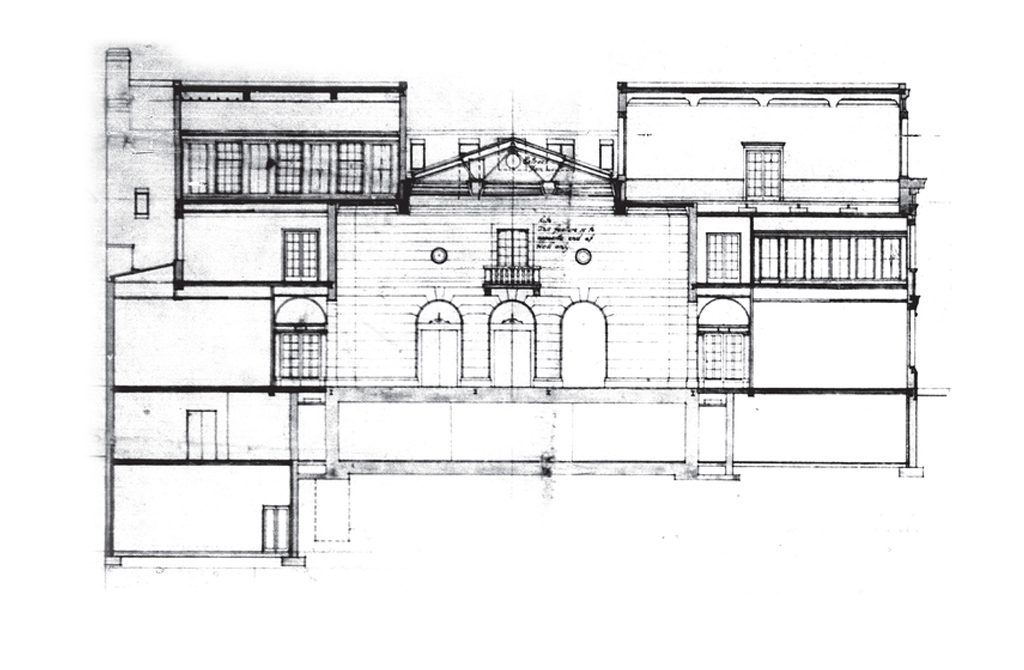
Section AA of the Municipal Bank
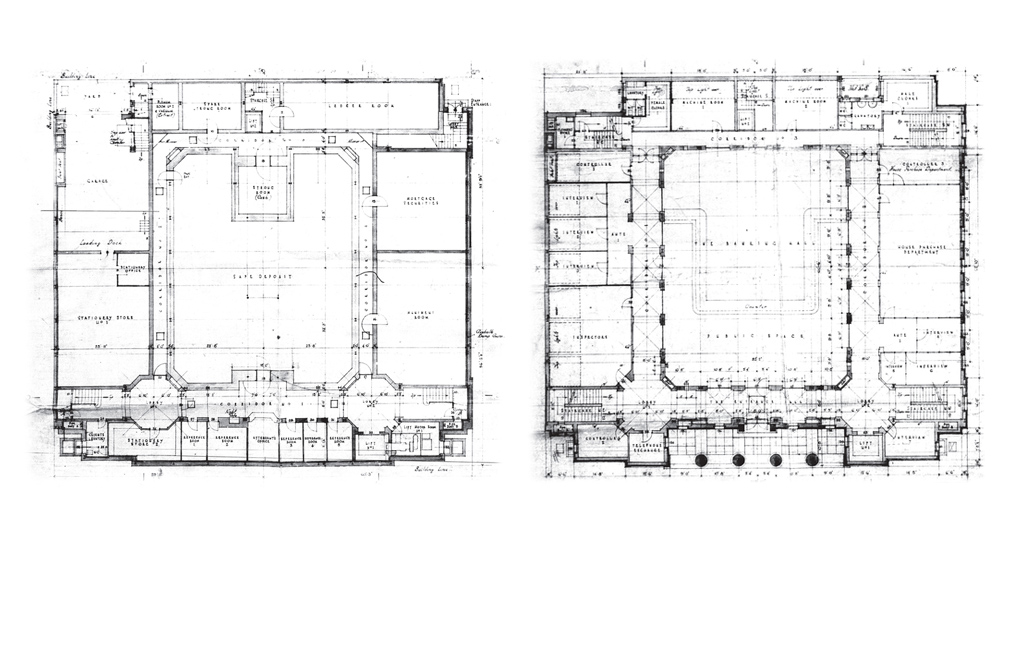
Plans for the basement and ground floor areas
The documents were discovered by Steve Townsend of Associated Architects – a man described as the city’s very own Indiana Jones of architecture – with the help of Library of Birmingham archivists who manage the excellent Iron Room blog.
Writing on the Hidden Spaces website Steve said: “A few months back we took a trip to the Library of Birmingham’s Archives, Heritage and Photography Centre, where we scoured the archives for the original architect’s drawings for the Birmingham Municipal Bank headquarters on Broad Street.
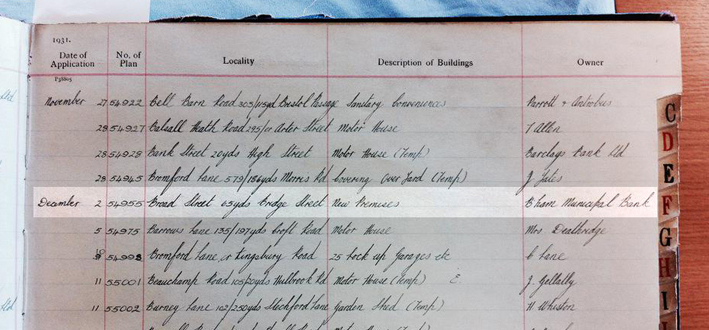
The original planning application for the Municipal Bank building
“With help from the amazing staff in the Wolfson Centre we were thrilled to locate the original planning application drawings by architect Thomas Cecil Howitt, submitted on 2 December 1931.”
The Municipal Bank is a remarkable reminder of Birmingham’s financial and corporate might, designed by Thomas Cecil Howitt, the architect of the nearby and equally grand Baskerville House.
Interior walls are adorned with salient messages such as ‘thrift radiates happiness’ and ‘saving is the mother of riches’.
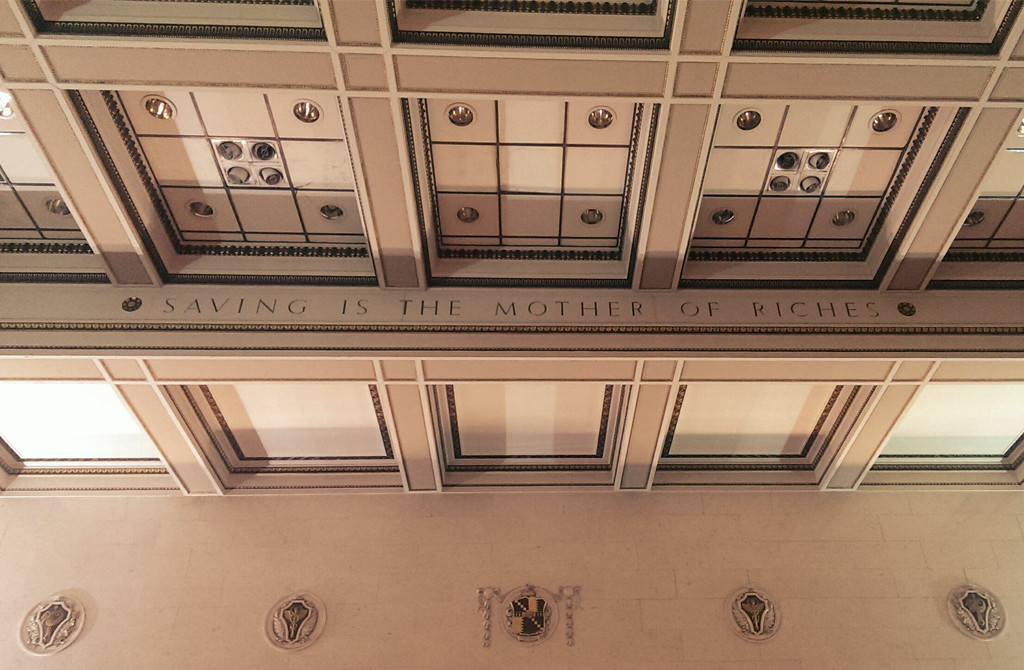
‘Saving is the mother of riches’, inside the Municipal Bank
It was first set up after the First World War as a savings bank for the citizens of Birmingham by Neville Chamberlain, the Lord Mayor of the city at the time.
On October 22, 1932, the foundation stone was laid, and the building was opened by HRH Prince George on November 27 1933.
The important building will be at the heart of the vast Arena Central regeneration scheme and the new headquarters for HSBC’s UK operations, a move that plays perfectly into the story of the city’s banking and financial heritage.
Images reproduced by Birmingham’s Hidden Spaces with permission from Library of Birmingham
While there’s no denying Birmingham made some pretty ghastly planning mistakes in the post-war years, not everything went the way of the bulldozer.
Take a walk around Temple Street, Bennetts Hill and New Street, look up from your smartphone and you’ll spot a selection of delightful doorways displaying typographic designs from a bygone era that, thankfully, are still with us.
The Hortons-built White House from 1912 offers a wonderful example of pre-war signage over its entrance on New Street, while the glorious Birmingham Law Library no longer occupies its Temple Street building but its original doorway is quite stunning.
Further down Temple Street and the Temple Buildings entrance could easily grace a New York high-rise.
Bennetts Hill has a mixture of building styles and one of its most grand is the Scottish Widows building, constructed in 1931. Its elegant entrance survives despite changes of usage.
Buildings change over the years; from offices to apartments; from retail to restaurants. Here’s hoping these little snapshots of their early years are here to stay.
Spotted any others? Tweet a picture @staceybarnfield







